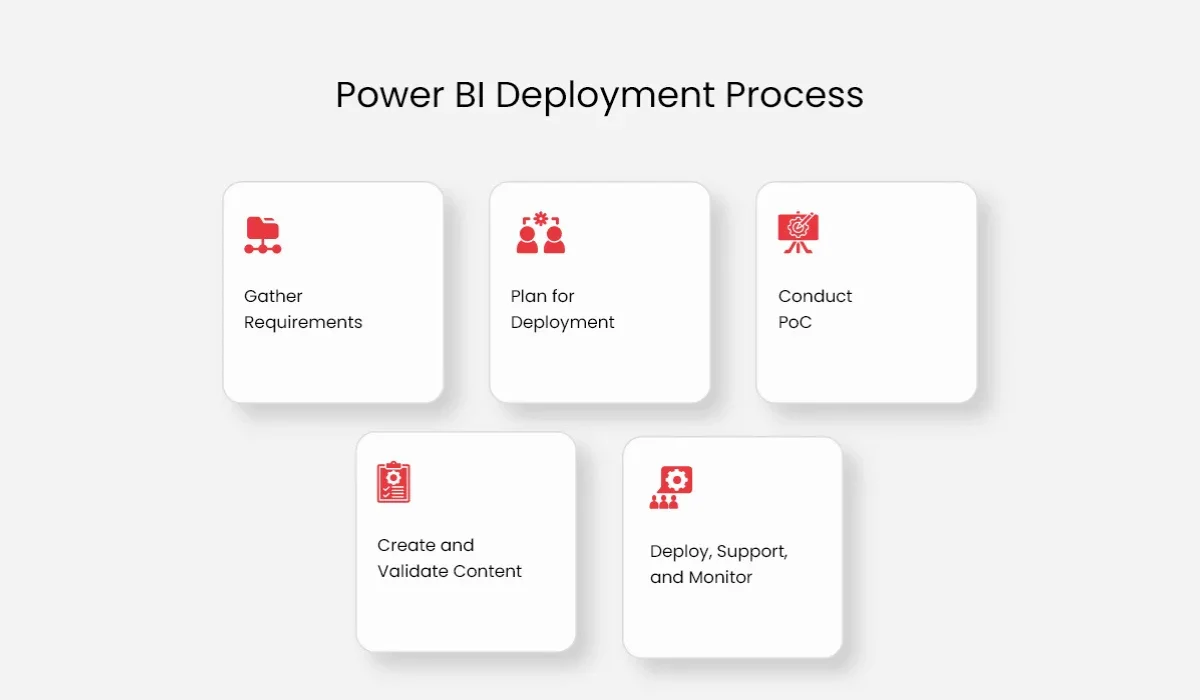Microsoft created extremely robust software that can be customized in an infinite number of ways for Power BI deployment in your enterprise. This platform is built to work with other popular services that Microsoft has bought or developed, such as Azure Synapse, AI and Machine learning, the Common Data Service, and others.
This compatibility means that you’ll need to be very careful when planning for Power BI implementation for the following reasons:
- You’ll need a Lego assortment of possibilities that include architectures, assemblies, security setups, and distribution.
- You’ll need to plan everything so that every component of your chain is in place when it’s needed.
- You’ll also need to be aware of the consequences of almost all of your choices, which can be extremely difficult to accomplish since the platform changes frequently.
The blog contains everything you need for the smooth deployment of Power BI in your enterprise.
The Importance of Detailed Planning
While Power BI is an enterprise-level project, it’s still necessary to be in the middle of the specifics for deployment.
Due to the need for a thorough understanding, you can’t plan for a Power BI deployment in a typical way, such as hitting ” the go” switch on an ERP implementation. It will require lots of testing and rethinking in response to the results. Poor performance could mean that you must start over with a new design.
Take help from BI consulting firms especially if this is your first time.
Start with Pre-Deployment Planning for Power BI Implementation
The distinction between a smooth implementation and a rough one usually depends on how much preparation was put into it. Power BI is surprisingly simple to set up, and the platform mainly includes Power BI Desktop as well as an online service on PowerBI.com that allows you to communicate reports. The issues arise when trying to connect PowerBI to an actual data source, like accounting software programs or CRMs.
The Pre-deployment stage is when you can combine teams from different departments to assist in setting up data connections to avoid much rework.
The second part is determining who will develop and handle the reports regularly. Consultants and developers on hire can be a fantastic source for a rapid beginning to deploy Power BI, but changes in business requirements and reports must be revised.
It is expected to require assistance from IT in establishing connections. Handle the data’s governance and create connections between different systems that consultants cannot access.
Here is a complete process we recommend to follow before deployment.
Power BI Deployment Process You Must Follow

1. Gather Requirements
Start by gathering the requirements first and designing the solution.
Appropriate specifications are crucial to ensuring effective solution deployment and acceptance. A good way to collect requirements is to determine and engage the appropriate participants, define the issue that must be resolved, and then use the common understanding to design a solution.
You can use a variety of approaches to interact with users and gather requirements. For instance, you can get requirements from technical design or business design.
Business design is a method for collecting business requirements. It is focused on engaging participants in business design sessions to collaborate on solutions. The final product of a business design consists of mock-ups of solutions and design documents.
Technical design is translating business requirements into technical specifications and considering design assumptions. Technical design is focused on proving the validity of a business model and defining the technical strategy to apply. To verify the design, content creators generally engage with experts from the technical field during focused discussions, referred to as technical design sessions, when required.
2. Plan for Deployment
Once the project team has finished gathering requirements, developing the solution plan, and getting approval to proceed, it’s time to prepare for the solution’s deployment.
The deployment planning process varies depending on your solution, development workflow, and deployment procedure. A deployment plan typically involves various tasks related to the design and implementation of the solution’s tools and processes.
3. Conduct a Proof of Concept
The project team is responsible for completing a prototype (POC) to verify the validity of existing assumptions and show initial benefits to business users. A POC is a first design-based implementation that is limited in terms of scope and maturity.
A well-managed POC is crucial for complex or large-scale business intelligence solutions since it can identify and address the complexities (or deviations) that weren’t identified in the design.
4. Create and Validate Content
If it is determined that a POC has been successful, the team moves to making and validating the content. The project team can create Power BI solutions through iterative development and validation. The cycles comprise iterative releases, in which the team develops the content within a test setting and transfers it into an environment for testing.
While developing, the project team slowly joins the community of users through an experiment to test the system’s early (beta) variants within the testing environment.
5. Deploy, Support, and Monitor
When the solution is complete, the project team can deploy the verified solution to an environment for production. The team responsible for the project should perform crucial adoption and follow-up actions to ensure the deployment goes off without a hitch.
You must complete the following adoption and support tasks to ensure your successful deployment.
- The Final Release Should Be Announced: The executive sponsor, manager, or any other person with enough authority and credibility must declare the new release in the user community. The announcement should be clear and short and hyperlink to appropriate solutions and support channels.
- Training for Content Consumers: Training should be accessible to content consumers during the initial weeks following production release. It should concentrate on defining the solution’s scope, answering users’ questions, and demonstrating how to utilize it.
- Respond to Feedback and Requests: Consider providing users with a means to submit feedback and suggestions to the team working on the project. Be sure that any reasonable comments and suggestions are considered and, if appropriate, implemented in the post-deployment support period.
- Plan to Engage with the User Community: After the period of post-deployment support has expired, ensure that the solution’s owners regularly attend meetings with the user community. These gatherings can be valuable sources of feedback that can be used to refine the Power BI strategy. Additionally, they aid in adopting your solution by providing users with tools.
- Transfer Actions: Some members of the project team may not be responsible for maintaining the solution. In this scenario, the team must determine the person responsible and then perform the handover. The handover must be done shortly after the production release and should include both the solution and the community of users.
Key Power BI Deployment Tracks
Once you have a clear understanding of the strategic goals and drivers, you can explore the details of Power BI deployment.
The following are a few of the primary issues and questions you’ll need to address to create this plan. They’re not exhaustive, but they can offer a glimpse of the magnitude of what you have to consider when planning your Power BI deployment.
1. Architecture
The first step is to make key architectural choices, such as:
- Do you use a cloud service, on-premise, or hybrid solution?
- What platform for data warehouses do you use? (i.e., Azure SQL DB, Azure Synapse, Snowflake)?
- Are you planning on working on data science projects?
- Do you require a Data Vault for historical tracking?
- What volume of data do you anticipate?
- Do you require a lake?
Do you plan to leverage the tools to automate your data warehouse (i.e., Wherescape)?
Next, consider questions such as:
- Do you intend to use certified datasets using Live Connect or Dataflows?
- Or do you let individuals go on in their ways using data that aren’t certified? (Don’t allow this!)
- Are you planning to use pipelines for deployment?
- Who can create data sets and publish them to an online workspace or even release an application?
- What are the best ways to develop pipelines and guidelines in these areas?
- Are you planning to use Power BI Pro or Premium?
The 2nd set of issues is in the governance boundary and has significant architectural implications.
2. Project Management
Within the “swim lane,” you must identify what roles are required for your Power BI deployment process. The deployment team should include:
- An Admin
- Power BI Capacity Admin
- Data Security Manager
- Data Steward
- Data Architect
- BI Developers
- Power BI Champion
You may need assistance from corporate sponsors to provide resources for the project. The Power BI team also needs to acquire the appropriate capabilities to carry out deployment (i.e., they must be knowledgeable about the agile method of working).
3. Scope and IT Involvement
It’s now time to get down to the scope of deployment (aka the way things are accomplished):
- Will you be completing an array of prototypes of concepts (POCs)?
- Do you want to start by using a model that everybody already knows how to utilize?
- Do your models need integration from different sources, or will you need to capture detailed information from them?
We often assist large corporations in creating the “mothership” model, which uses certified datasets and Live Connect. This model simplifies data organization and review. However, it can also remove some of the flexibility that BI and self-service provide, which requires greater IT involvement.
4. Governance
It is essential to create an appropriate data governance framework before installing Power BI to avoid problems that may affect the integrity and security of data. The governance framework you establish should cover workspace creation policies, tenant setup, and shared and secure data security policies.
Governance policies should be updated over time as new features are introduced, regulatory laws are adopted, and business requirements change.
5. Data Modeling
Power BI models built for commercial use must be dimensional Star Schema models. Anything else could be the biggest headache regarding maintenance, performance, and DAX functions.
You must comprehend the dimensional model and be aware of its architecture and ETL (extract transform, extract, and load) implications. Once you’ve got that understanding (or employ someone who has), you’ll have to be able to answer questions similar to those below.
- Are you planning to build large models? If yes, will you optimize the models or composite ones?
- Do you require low latency and excellent query performance? Joining or denormalizing the data can help.
- What happens within the warehouse for data?
6. Power BI Implementation Planner & Timeline
It helps you in structuring the plan for deploying Power BI in your organization. The planner includes key phases with clear deadlines and milestones for setup, development, testing, and more.
Conclusion
Implementing Power BI in an enterprise requires meticulous preparation, attention to particulars, and an in-depth knowledge of the software. By adhering to the recommended practices laid out in this blog post, you can ensure that the Power BI deployment is secure and reliable and help you make better decisions using your data.
Whether it is planning for the deployment, safeguarding the data, maximizing the performance, ensuring that it is version controlled, or monitoring and maintenance— the above practices play a crucial part. Leveraging these practices also lessens the risk and maximizes the potential value of your data. If unsure, it is best to take the help of a BI consulting firm.



